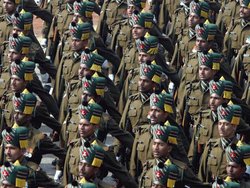Military of India
|
|
Military branches:
Indian Army, Indian Navy (including naval air arm), Air Force, various security or paramilitary forces (includes Border Security Force, Assam Rifles, Rashtriya Rifles, National Security Guards, Indo-Tibetan Border Police, Special Frontier Force, Central Reserve Police Force, National Cadet Corps, Defense Security Corps and several other units) and the Strategic Forces Command.
The Supreme Commander of the Indian Armed Forces is the President of India, currently Dr. A.P.J Abdul Kalam.
It is one of the largest and most powerful militaries in the world. The Indian Army is the third-most numerous army in the world, after the People's Republic of China and United States. Since its formation, the Indian Army has fought in both World Wars. Post-independence, it has fought three wars against Pakistan (1948, 1965, and 1971) and a war against China in 1962. India also fought an extended border skirmish with Pakistan over a part of Kashmir in 1999.
The Indian military possesses nuclear weapons and sufficient means - a range of missiles and aircraft - to deliver these over considerably long distances. However, India has a nuclear no-first-use policy and maintains a nuclear doctrine based on "credible minimum deterrence." India is not a part of the nuclear non-proliferation treaty, citing concerns that it unfairly favours the established nuclear powers, and provides no provision for complete nuclear disarmament. Indian officials argued that India's refusal to sign the treaty stemmed from its fundamentally discriminatory character; the treaty places restrictions on the nonnuclear weapons states but does little to curb the modernization and expansion of the nuclear arsenals of the nuclear weapons states.
| Contents |
Military manpower
The data regards Males age 15-49
| Military age | 16 years of age | |
| Availability | 287,551,111 (2005 est.) | |
| Fit for military service | 219,471,999 (2005 est.) | |
| Reaching military age annually | 11,446,452 (2005 est.) |
<tr><td>Active troops<td>1,325,000 (Ranked 3rd) |
Military expenditures
| Dollar figure | 16.97 billion US $ (2004) |
| Percent of GDP | 2.5% (2004) |
Military Branches of India
The highest wartime gallantry Award given by the Military of India is the Param Vir Chakra. Its peacetime equivalent is the Ashoka Chakra. The highest decoration for meritorious service is the Param Vishisht Seva Medal.
References
India Nuclear Forces (http://www.fas.org/nuke/guide/india/nuke/) CIA World Factbook 2005 (http://www.cia.gov/cia/publications/factbook/geos/in.html) Further reading: A. Kundu (1998) Militarism in India: The Army and Civil Society in Consensus
External Links
Bharat Rakshak (http://www.bharat-rakshak.com/) - The consortium of Indian military websites
Indian Armed Forces (http://www.armedforces.nic.in/) - The official site



